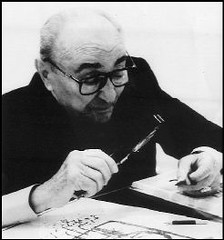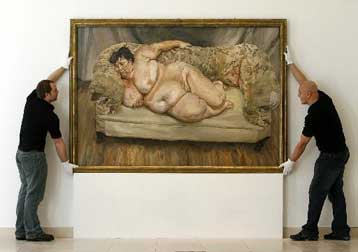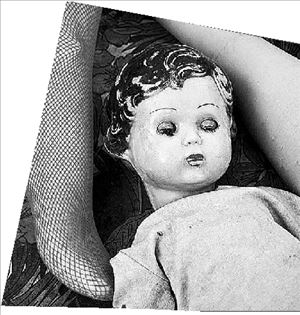
Wednesday, 2 April 2008, The Independent
Angus Fairhurst was a central part of the group known as the YBAs (Young British Artists). In 1986 he went to study at Goldsmiths' College in London where among his fellow students were Sarah Lucas and Damien Hirst. This led to friendships and collaborations that were to continue over the next 20 years, and included the 2004 show "In-A-Gadda-Da-Vida" at Tate Britain, which showcased the triumvirate.
While at Goldsmiths', Fairhurst studied with Michael Craig-Martin and Julian Opie and there were reflections of this artistic heritage in his adoption of the graphic image and clean crisp colours in his paintings and screen works. He was interested in popular culture and used images found in magazines, altering them by removing areas. It was this removal that made his work seem to be about destruction and negativity.
Fairhurst appeared in all the iconic contemporary art shows of last two decades. He was one of the original group of artists selected by Hirst for his 1988 "Freeze" show in a London warehouse. In 1994, his work appeared in "Some Went Mad . . . Some Ran Away", curated by Hirst at the Serpentine Gallery – the title "borrowed" from Fairhurst's own show at Karsten Schubert's gallery three years before. He was included in "Brilliant: art from London" at the Walker Art Center, Minneapolis, in 1995 and the Royal Academy's "Sensation" in 1997, and his work was also shown at the Serpentine as part of "In the darkest hour there may be light: works from Damien Hirst's murderme collection" in 2006.

Fairhurst worked in a variety of materials: sculpture, film, photography, video and installation, which makes his work hard to categorise. He was a cerebral artist and loved jokes. For one of his pieces, Gallery Connections (1994) first shown at Karsten Schubert's gallery, Fairhurst hotwired the phone lines of art galleries to make them telephone each other – the resulting confusion made hilarious reading when the transcription was published in Frieze magazine. But he was making a serious comment on how hermetically sealed the art world is and how its inhabitants only talk to each other.
Fairhurst's strongest works were often about wiping out iconic images, as in his Billboard, Everything but the Outline Blacked-in (2003), in which he erased all of the model Sophie Dahl from her nude and very memorable perfume ad. In a black-and-white drawing the title explains the work, "My house fell down but now I can see the stars".
In the 1990s Fairhurst introduced a gorilla, and gorilla suits, to his work. He had first employed the device in the video A Cheap and Ill-Fitting Gorilla Suit (1995), in which the artist was seen jumping up and down in such a costume until it disintegrates. In "In-A-Gadda-Da-Vida", and later as part of Hirst's murderme collection, the gorilla reappeared, this time as a substantial bronze. A Couple of Differences Between Thinking and Feeling II (2003) pathetically portrays the gorilla with one arm detached in front of a messy psychedelic backdrop. When asked about the gorilla, Fairhurst's response was, "underneath this big hairy masculine thing, there I was in the end, a skinny lanky geezer".
Fairhurst was part of a conceptual band called Lowest Expectations (or sometimes Low, sometimes Lower) which made its first public appearance in 1995 supporting Pulp at Brixton Academy. Their performances had all the trappings of a generic rock concert: instruments and amps, a massive sound system, psychedelic lighting, giant video projections, a cramped space packed with hot and sweaty people, and a bar. The only difference was that when the artists took to the stage none of them actually played any music. Instead, Fairhurst and his band mimed to a selection of pre-recorded music, turning the evening into a spectacle of posing and posturing. The band went on to have 13 gigs between 1995 and 2001.
His friendship with Hirst and Lucas was longstanding, despite their greater success. Fairhurst was "happy being in the slipstream" of the others, said Schubert. In the Hirst/Fairhurst partnership, Fairhurst was the tall attractive one compared to Hirst, shorter and more truculent. I met them together in Venice in 2001, at Mark Wallinger's party on an island in the lagoon. I started to talk to Hirst and he suddenly flipped, calling me every name under the sun. Fairhurst grabbed him and dragged him away. When I got back to London I went to thank Fairhurst in his modest studio in Clerkenwell. There were several Sarah Lucas cigarette sculptures around, an indication of their closeness. He was working on animations and they were very, very rude.
Fairhurst's last show, at Sadie Coles HQ in London, closed last Saturday, the day he was found dead.
Karen Wright
Angus Fairhurst, artist: born Pembury, Kent 4 October 1966; died Bridge of Orchy, Argyll 29 March 2008.







![Gino Severini (1883-1966) - Donna che legge [Odalisca con specchi], 1942 - Oil on canvas - 60 x 50 cm - Private collection Gino Severini (1883-1966) - Donna che legge [Odalisca con specchi], 1942 - Oil on canvas - 60 x 50 cm - Private collection](http://www.artknowledgenews.com/files2007a/GinoSeveriniDonnaCheLegge.jpg)










